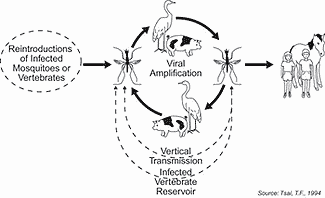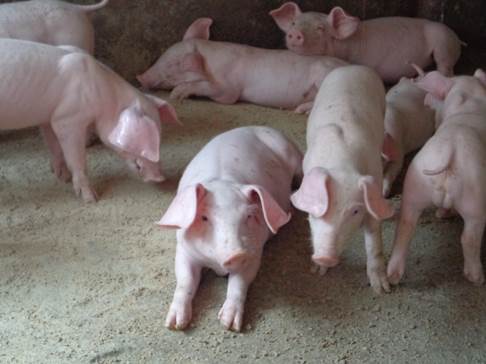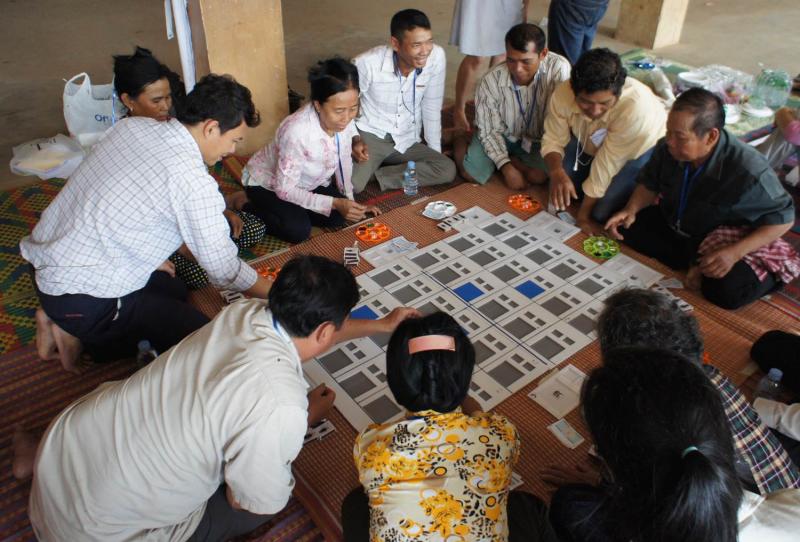
Latest Results on Encephalitis case study (Cambodia)
This case study addresses the impacts of Nipah Virus (NiV) and Japanese Encephalitis Virus (JEV) management at national, provincial and municipal levels in Cambodia.
"Contribute to a better management of Encephalitis' diseases in South East Asia and Cambodia with a focus on Nipah and Japanese viruses for commnunities and at a provincial level"
The encephalitis case study is the study of the Japanese Encephalitis and the Nipah Virus. Both are viruses found in South East Asia, responsible for zoonotic diseases and their symptoms are caracterised by headaches. Moreover, Encephalitis are perceived by local communities as a unique disease. It might be possible then, to consider the prevention and surveillance as a common approach for all encephalitis.
 Japanese Encephalitis Virus (JEV) is the most important cause of acute human encephalitis in Eastern/Southern Asia. Its epidemiology involves wild birds as reservoir, domestic pigs as amplifier host and environment-dependent mosquito species as vectors, explaining why cross-sectorial collaboration with non-traditional health actors is essential. JEV is classically described as a rural disease related to rice growing activities such as paddy fields flooding. An effective human JEV vaccine is available and data from Thailand and Vietnam show that vaccination has dramatically decreased the number of JEV cases even though cases are still observed, notably in peri-urban areas.
Japanese Encephalitis Virus (JEV) is the most important cause of acute human encephalitis in Eastern/Southern Asia. Its epidemiology involves wild birds as reservoir, domestic pigs as amplifier host and environment-dependent mosquito species as vectors, explaining why cross-sectorial collaboration with non-traditional health actors is essential. JEV is classically described as a rural disease related to rice growing activities such as paddy fields flooding. An effective human JEV vaccine is available and data from Thailand and Vietnam show that vaccination has dramatically decreased the number of JEV cases even though cases are still observed, notably in peri-urban areas.
At least 50,000 cases of JEV are reported annually (with around 12 million of asymptomatic cases).This is an underestimation of disease incidence since incidence rates during outbreaks can reach >100 cases per 100,000 population. The disease mainly affects children. Most adults from endemic countries have natural immunity after being in contact with the infection during childhood, but it cans affect at any age.
Most infections by the virus of Japanese encephalitis are benign (with fever and headache) or without apparent symptoms but in about 1 in 250, they cause serious disease characterized by sudden onset of high fever, headache, coma, etc... The case fatality rate can reach 30% of symptomatic cases.
According to what has been discussed at the end of year 1 with the stakeholders identified during the ComMod PARDI process, field activities have been implemented and the project’s stakeholders started to develop a generic model of Japanese encephalitis circulation in Cambodia. The announcement by the Cambodian government that it will launch a nationwide JE vaccination program for one year, beginning in 2016, leads to the redefinition of the objectives of the JE case study. We decided to organize a major workshop on JE control in Cambodia in order to collect evidence of the burden of JEV in Cambodia and to share knowledge on the epidemiology of the disease in order to promote prevention measures in year 3.
This workshop has been held in Phnom Penh on the 15th of September 2015. It has been organized by the “Institut Pasteur du Cambodge”, the Communicable Disease Control Department (CDC-MoH) and the National Immunization Program of the Ministry of Health (NIP-MoH). National authorities and hospitals in charge of Japanese Encephalitis surveillance and control, and by international experts presenting the state of the art of JE and more particularly its situation in Cambodia. The adoption by Cambodia government of a mass vaccination program to control JE will be taken into account by the PhD candidate who started in September 2015.
The epidemiology of Japanese Encephalitis virus has been studied by collaborators at the Institut Pasteur du Cambodge, during the 3rd year of the project, to understand the risk in rural area, the role of domestic birds and if a pig to pig transmission is plausible. The results were the subject of a scientific article published in PLoS Neglected Tropical Diseases (Cappelle J & Al. (2016)). The article can be found in the communications and publications tab.
 The study estimated the Force of Infection (FOI) of JE in 2 cohorts of sentinel pigs settled in a peri-urban area of Phnom Penh. The model estimated that during that period for the first cohort, a susceptible pig had a 3.19% probability of acquiring JEV infection each day. For the second cohort, a susceptible pig had a daily probability of 4.64% of acquiring JEV infection during that period.
The study estimated the Force of Infection (FOI) of JE in 2 cohorts of sentinel pigs settled in a peri-urban area of Phnom Penh. The model estimated that during that period for the first cohort, a susceptible pig had a 3.19% probability of acquiring JEV infection each day. For the second cohort, a susceptible pig had a daily probability of 4.64% of acquiring JEV infection during that period.
The comparison of the peri-urban and rural FOI showed that the rural ROI (8.4%) was higher than the peri-urban one (6.6%). After estimating the risk of JE transmission to humans associated with a peri-urban pig slaughterhouse of Phnom Penh, they concluded that the number of human clinical cases due to this abattoir is not null and is highly influenced by the mosquito population size and the proportion of infected pigs arriving thus the epidemiological situation of JE in the country.
The model set to study the role of domestic birds in the transmission of JE showed no significant association between the pigs and birds JE sero-prevalence. About the pig to pig transmission, a previous study has experimentally demonstrated the direct transmission, but the model used by the collaborators from IPC and applicate to real life condition, showed that the contribution of the pig to pig transmission could be around 10%.
 The Nipah virus emerges in Malaysia between 1998 and 1999, it caused the hospitalization of 265persons, 105 deaths (whether 40% of the infected). It touched mostly adult males being pig farmers. At this time the intermediate host was the pig, this has led to great economic loss with the slaughter of 1.1million of pigs on a pig population of 2.4 million.
The Nipah virus emerges in Malaysia between 1998 and 1999, it caused the hospitalization of 265persons, 105 deaths (whether 40% of the infected). It touched mostly adult males being pig farmers. At this time the intermediate host was the pig, this has led to great economic loss with the slaughter of 1.1million of pigs on a pig population of 2.4 million.
In 2004, Bangladesh, people have been infected with Nipah virus after eating fresh date palm juice that had been contaminated by fruit bats. Human transmission has also been reported, particularly in a hospital in India. Flying foxes (Pteropus sp) seems to carry the virus without being affected. The virus has been found in their urine and saliva.
Human’s clinical symptoms range from asymptomatic infection to an acute respiratory syndrome and fatal encephalitis. Nipah virus can also cause disease in pigs and other domestic animals. There is no vaccine for humans or animals.
The main topics that we have addressed in the framework of this case study are the following: Modelling of JE transmission in Cambodia, Risk mapping of JE in Cambodia, Emerging encephalitis eco-epidemiology and Nipah virus, Ecology of cave bats and emerging encephalitis.
It can be noted that the anthropological studies implemented during year 1 showed that encephalitis was perceived as a single health issue by local communities. We then decided to merge the JE and Nipah case studies into one Encephalitis case study, in particular for designing the next step of the project and the participatory modeling activities. We designed a Role Playing Game (RPG) representing the main activities of communities at the local level and “play” sessions with local stakeholders on the field at the commune level, in the three sites we are implemented bat surveys. Local stakeholders have to play their own role and activities regarding livelihoods and agriculture.
The use of RPG enables knowledge exchange between participants (i.e. communities and experts) and allowed collecting semi-quantitative data and qualitative data, important to set the context and the possible paths of transmission but also to understand the knowledge of the local population about these diseases.
The RPG can be used as a tool for prevention and communication among local stakeholders and researchers, by sharing, collecting knowledge, and helping local populations to understand and manage the disease.
Field and research activities have been implemented in collaboration with the SEA project (involving three members of ComAcross consortium: Pasteur Institute, LOMWRU and CIRAD).
Cross-sectoral collaboration on zoonotic diseases in South East Asia and Cambodia is needed:
To understand the biology and ecology of NiV and the socio-economic dynamics.
To identify the potential route of transmission of the NiV from Flying Foxes to Humans and domestic animals.
To identify the risks and health and economic impacts of Japanese encephalitis virus on humans and pigs, and find how thoses effects could be reduced in a cost-effective and sustainable manner.
To collect evidences of JE burden and of JE control possibilities through reviewing and research activities.
To describe and compare the epidemiologic dynamic of JE between rural and peri-urban settings in Cambodia.

This case study addresses the impacts of Nipah Virus (NiV) and Japanese Encephalitis Virus (JEV) management at national, provincial and municipal levels in Cambodia.

A role playing game is currently under development in the framework of the Encephalites case study, and has been pre-tested during a workshop facilitated by Dr.

The Encephalitis case study embraces 2 model diseases: Nipah Virus and Japanese Encephalitis.